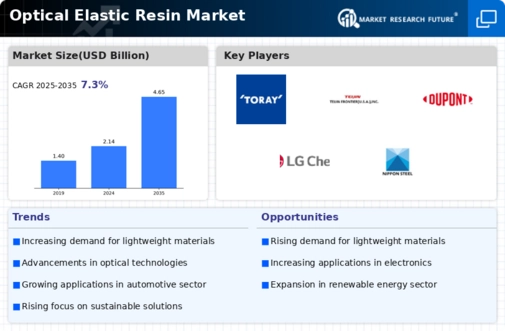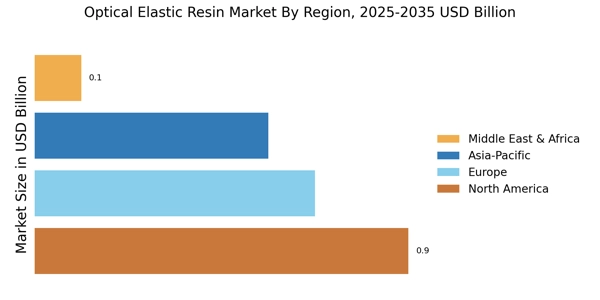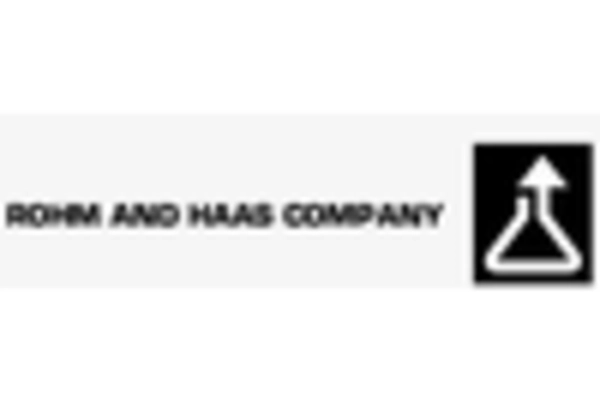Advancements in Optical Technologies
Technological advancements in optical technologies are significantly propelling the Optical Elastic Resin Market forward. Innovations in manufacturing processes and material formulations have led to the development of resins that offer enhanced optical clarity, durability, and resistance to environmental factors. For instance, the integration of nanotechnology in resin production has resulted in materials that exhibit superior light transmission properties. The optical industry, particularly in the production of high-performance lenses and displays, is projected to grow at a rate of around 6% annually, further stimulating demand for optical elastic resins. As these technologies evolve, the Optical Elastic Resin Market is likely to benefit from increased applications in consumer electronics, medical devices, and advanced imaging systems.
Growing Applications in Medical Devices
The Optical Elastic Resin Market is witnessing a surge in applications within the medical device sector. The demand for high-performance materials that can withstand sterilization processes while maintaining optical clarity is driving the adoption of optical elastic resins. These materials are increasingly utilized in the production of surgical instruments, diagnostic equipment, and imaging devices. Recent statistics indicate that the medical device market is expected to expand at a compound annual growth rate of approximately 7% over the next five years, which bodes well for the Optical Elastic Resin Market. As healthcare continues to evolve, the need for innovative materials that enhance device performance and patient outcomes will likely fuel further growth in this segment.
Rising Demand for Lightweight Materials
The Optical Elastic Resin Market is experiencing a notable increase in demand for lightweight materials across various sectors, particularly in automotive and aerospace applications. As manufacturers seek to enhance fuel efficiency and reduce emissions, the adoption of lightweight materials becomes paramount. Optical elastic resins, known for their superior strength-to-weight ratio, are increasingly favored for components such as lenses and structural parts. According to recent data, the automotive sector alone is projected to witness a compound annual growth rate of approximately 5% in the use of lightweight materials, which directly influences the growth trajectory of the Optical Elastic Resin Market. This trend is likely to continue as industries prioritize sustainability and performance, thereby driving innovation and investment in optical elastic resin solutions.
Increased Focus on Aesthetic Applications
The Optical Elastic Resin Market is also benefiting from an increased focus on aesthetic applications, particularly in the fashion and consumer goods sectors. As brands strive to differentiate their products, the use of optical elastic resins in eyewear, jewelry, and decorative items is becoming more prevalent. These materials allow for intricate designs and vibrant colors, appealing to consumers' desire for personalization and uniqueness. Market analysis suggests that the eyewear segment alone is projected to grow by approximately 4% annually, driven by trends in fashion and lifestyle. This emphasis on aesthetics is likely to encourage manufacturers to explore innovative uses of optical elastic resins, thereby expanding the market's potential.
Sustainability and Eco-Friendly Initiatives
Sustainability initiatives are increasingly influencing the Optical Elastic Resin Market as manufacturers and consumers alike prioritize eco-friendly materials. The shift towards sustainable production practices is prompting the development of bio-based optical elastic resins that reduce environmental impact without compromising performance. As regulatory frameworks become more stringent regarding material sourcing and waste management, companies are compelled to adapt. Recent data indicates that the market for sustainable materials is expected to grow at a rate of around 8% annually, which is likely to enhance the appeal of optical elastic resins. This trend not only aligns with consumer preferences but also positions the Optical Elastic Resin Market favorably in a competitive landscape that values sustainability.


















Leave a Comment